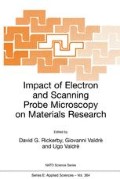Abstract
The key to the imaging technology in the ESEM is the ionization of gas molecules by the secondary electrons from the sample and the collection of this amplified signal. Secondary electrons that are generated by the interaction of the primary electron beam with the sample are the signal of choice for high resolution imaging. The primary beam strikes a sample generating both secondary and backscattered electrons. In the ESEM, the secondary electrons are specifically collected by a confined electrostatic field that is generated by gaseous secondary electron detector above the sample. Within this field, the secondary electrons strike gas molecules generating an additional electron; a process termed cascade amplification. The image formed by collection of these electrons is very similar to the image formed by the conventional Everhart-Thornley detector, even though the signal amplification process is different. Scattering of the primary beam electrons also results in the formation of amplified electrons, but contains no relevant image information.
Access this chapter
Tax calculation will be finalised at checkout
Purchases are for personal use only
Preview
Unable to display preview. Download preview PDF.
References
Danilatos, G.D., (1990) Theory of the Gaseous Detector Device in the Environmental Scanning Electron Microscope, Advances in Electronics and Electron Physics, 78, 1–102.
Goldstein, J.I., et.al., (1992) Scanning Electron Microscopy and X-Ray Microanalysis, Plenum Press, New York
Author information
Authors and Affiliations
Editor information
Editors and Affiliations
Rights and permissions
Copyright information
© 1999 Springer Science+Business Media Dordrecht
About this chapter
Cite this chapter
Hardt, T.A. (1999). Environmental SEM and Related Applications. In: Rickerby, D.G., Valdrè, G., Valdrè, U. (eds) Impact of Electron and Scanning Probe Microscopy on Materials Research. NATO Science Series, vol 364. Springer, Dordrecht. https://doi.org/10.1007/978-94-011-4451-3_18
Download citation
DOI: https://doi.org/10.1007/978-94-011-4451-3_18
Publisher Name: Springer, Dordrecht
Print ISBN: 978-0-7923-5940-1
Online ISBN: 978-94-011-4451-3
eBook Packages: Springer Book Archive

